Reducing CO2 emissions
The Nikon Group implements various measures to reduce CO2 emissions based on the mindset of continuously growing our business while protecting the environment. We will continue to include CO2 emissions reduction as one of our management priorities as we work to help create a low-carbon society through measures including thorough energy conservation, making use of natural energy, and offering products with high energy efficiency* throughout their lifecycles.
- *Energy efficiency
The Nikon Group defines energy efficiency as the degree of functionality of each product per unit of power consumption.
Energy efficiency of a product = Degree of functionality/Unit of power consumption
Functionality is defined separately for each product type. The Nikon Group is always committed to releasing new products with higher energy efficiency.
CO2 emissions from Nikon Group companies in Japan
The Nikon Group is working continuously to reduce its CO2 emissions by implementing measures that include increasing the efficiency of HVAC and lighting equipment, improving production activities, managing the use of lighting and OA devices, and making more use of renewable energy.
In the year ended March 31, 2012, the total CO2 emissions of Nikon Group companies in Japan were 116 thousand tons, meaning we achieved our target of 126 thousand tons. (After the method for calculating emissions was changed, total emissions was 127 thousand tons compared to our target of 138 thousand tons.)
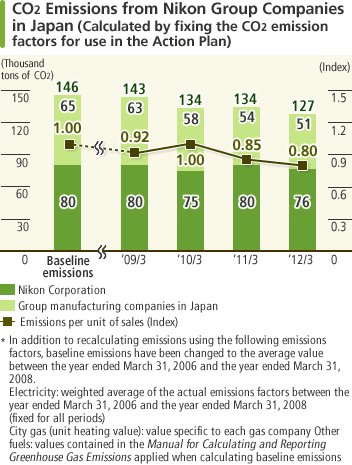
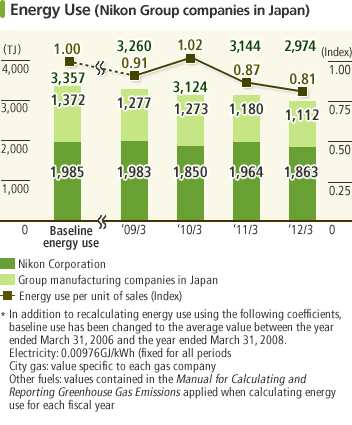
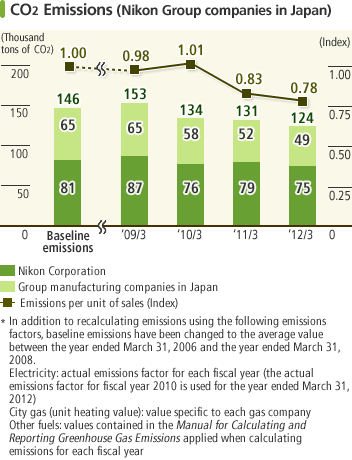
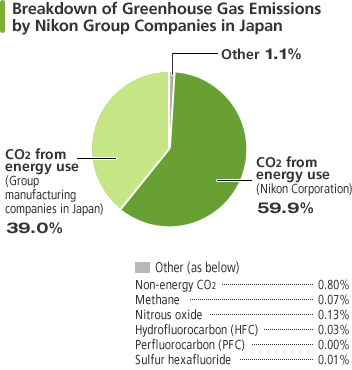
Examples of CO2 emissions-reduction measures by Nikon Group companies in Japan
Introduction of a steamless HVAC system

Heat pump chiller equipment of the steamless HVAC system
Tochigi Nikon Precision Co., Ltd. introduced a steamless HVAC system in its clean room to efficiently generate heat. As a result of installing this system, the company has reduced its CO2 emissions by 2,265 tons on an annual basis.
Utilizing renewable energy
The Kumagaya Plant has been operating a solar power generation system at full capacity since January 2010. The system is part of a joint research project with the New Energy and Industrial Technology Development Organization (NEDO). The system generates at least 100,000 kWh of power per year, which results in a reduction of CO2 emissions by about 50 tons. Additionally, the Yokohama Plant also cosponsors Yokohama City's project for wind power generation as a Y(Yokohama) Green Partner Company.

Monitor showing the amount of power generated in real time

Solar power generation panel

Yokohama Plant's certificate for green power
Initiatives at other facilities

LED lighting at the Shonan Branch, Sagamihara Plant
When it is time to replace equipment that has reached the end of its useful life, we actively encourage facilities in the Nikon Group to introduce high-efficiency equipment (LED lighting, air-conditioning, compressors, transformers, etc.) and to switch fuels for boilers. For example, the Sagamihara Plant and its Shonan Branch replaced some of the mercury and fluorescent lights in their offices and processing rooms with LED lighting. In addition, the Kumagaya Plant has introduced three commuter buses powered by natural gas with the aim of reducing CO2 emissions.
CO2 emissions from Group manufacturing companies in Asia
In the year ended March 31, 2012, the CO2 emissions per unit of real output from Group manufacturing companies in Asia were reduced by 20%, clearing the target of a 20% reduction. The absolute emissions were 66 thousand tons compared to the target of 88 thousand tons.
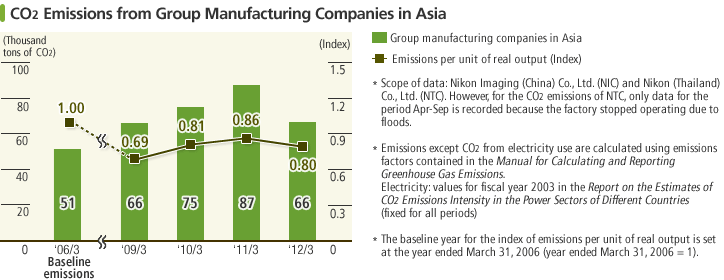
Examples of CO2 emissions-reduction measures by Group manufacturing companies in Asia
Introduction of solar powered LED lighting

Solar-powered outdoor lights at NTC
Nikon (Thailand) Co., Ltd. (NTC) has installed LED outdoor lights that utilize solar power generation at 42 locations around its factory grounds. In this way they have reduced their annual CO2 emissions by around 27 tons. During the year ended March 31, 2012, although affected by the floods, NTC resumed using them from November 2011.
